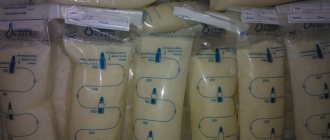All the necessary components - fats, proteins, carbohydrates and mineral salts, as well as vitamins - are contained in breast milk.
The first months of a child’s life are characterized by high rates of growth and weight gain.
The only food for him during this period is breast milk or its substitutes, since this is the most physiological food for the baby.
All the necessary components - fats, proteins, carbohydrates and mineral salts, as well as vitamins - are contained in mother's milk exactly in the quantity and ratio that the child needs.
Breastfeeding helps the normal development and growth of the newborn, increases the body's resistance to various types of infections.
The uniqueness of mother's milk also lies in the fact that it protects the baby from all diseases, because he receives it directly from the breast, warm and sterile. This means that the risk of disease is reduced, and the digestive process proceeds in favorable conditions.
When to start feeding your newborn
Surely, you have more than once watched with emotion videos in which newly born baby animals, hobbling on legs trembling from weakness or funny moving their paws, reach for their mother’s nipple. These tiny, often still blind lumps are controlled by a powerful force - the thirst for life. This is how nature ordered it.
And the health of the little man largely depends on how quickly after birth he is put to the breast . The colostrum released in the first hours is a real mother’s blessing for her baby to lead an independent life. This is a powerful amulet against many infectious (and other) diseases and an invaluable source of nutrients.
Unfortunately, colostrum very quickly loses its beneficial properties, remaining just a high-calorie food after just a few hours. Therefore, for many years, the World Health Organization has strongly recommended that all babies be put to the breast immediately after birth. Not for feeding - for a healthy future .
Not all children, being in a state of postpartum stress, are able to immediately actively suck. Don't worry: the first tiny drops of colostrum are easily released when you press on the areola. The baby will just have to lick them off. Then he will sleep soundly for several hours, resting after a difficult period of childbirth. But when should a mother start to really feed him, teaching him to latch on correctly - read here.
Basic positions for breastfeeding
The process of breastfeeding takes a lot of time, so the position for it, first of all, should be comfortable. There is no single rule for what position a newborn should be fed in, as every mother likes different positions. Some manage to feed their babies in the most extreme and uncomfortable positions at first glance, but most mothers choose one or two of the main positions for feeding:
- sitting feeding, or “cradle” - the mother sits in a chair or on the sofa, placing pillows under her back and elbows. The baby is in his arms, his body is turned with his tummy to the mother's belly, and his head is at the level of the nipple. With one hand, the mother constantly supports the baby’s shoulders and back, providing him with a comfortable position, and with the other she helps the baby to grasp the nipple correctly;
- “under-arm” feeding is an advantageous position for mothers who gave birth by caesarean section, since in this position the baby does not put pressure on the stomach. The baby is placed on the side of the sitting mother on a high pillow, so the baby is in close proximity to the breast, and the mother can control its position with her hand;
- Lying down feeding is an ideal choice for night time, as both mom and baby can rest and get some sleep. Mom lies on her side, baby next to her - belly to belly. The newborn's head in this position should be slightly raised, the torso in a level position, and the neck straight. If the mother is lying on her right side, then the baby should be applied to the right breast and vice versa. The breast, located below, is much closer to the baby’s mouth, so he does not have to arch his neck and reach for the nipple, and milk flows from it faster, which also makes it easier to obtain nutrition;
- feeding on the back - this position of breastfeeding allows the mother to rest well. In this case, the baby lies with his tummy on the mother's stomach, who holds him so that he does not fall. In this position, the child has to make some effort to produce milk, so this position is not recommended for weak and sick children;
- Feeding in a sling is a universal position for different situations. This device allows you to put your baby to the breast while sitting, standing or even while walking. With the help of a sling, you can feed your child on the street or at a party, without interrupting the feeding process; you can even do simple housework, for example, washing dishes or folding laundry.
Useful: Simple recipes for carrot puree for infants
Feeding the baby in one position or experimenting with variations of positions is the job of every mother, the main thing is that the baby and you feel comfortable and comfortable during breastfeeding. Proper breastfeeding from the very birth of your baby will save a lot of your time and nerves, and will also prevent stagnation of milk.
How to properly attach a baby to the breast
With the correct latching technique, feeding does not cause any difficulties for either the mother or the baby. Please note: the baby will latch onto the nipple correctly if he not only has his mouth open, but also his tongue is stuck out a little forward and curved in a boat shape . Then he will accept mother’s breasts tenderly, as if in folded palms, and he will suck on them so that the movements of his rough tongue will give mother unearthly pleasure.
The technique of proper breastfeeding is described in detail here. Compliance with it will 99% protect a woman from the formation of monstrously painful nipple cracks, from lactostasis and mastitis. And the baby will not suffer from intestinal colic and endless regurgitation.
How to teach a baby to latch on?
- Choosing the right position. The newborn should grasp the nipple along with the areola. The flow of milk and the mother’s sensations directly depend on the depth of the nipple’s grip in the little miracle’s mouth. If only the edge of the nipple is taken, the woman will feel pain and discomfort. For everything to go well, the child needs to be placed in his mother’s arms, with his back and neck supported on them. You can also feed in bed, then the mother lies on her side, and the baby is next to her, facing her. It is necessary to choose the most comfortable position so that the woman’s back does not become stiff, her head does not hang, and her arms are not tense.
- Maximum help for the child. In order for the toddler to grasp the nipple correctly, you need to direct the breast towards his nose. Feeding should not be forced, so you need to see that the baby's mouth is open. This usually happens reflexively, but you can also help the baby: just put your finger on the chin or move the nipple over the baby’s lips. When the mouth opens, you can serve the breast.
- During feeding, it is necessary to press the baby to the mammary gland, and not vice versa. You need to do everything possible to ensure that the baby takes the breast correctly, only then will it become a habit and problems with eating will disappear forever.

How to properly remove the nipple from your baby's mouth
In fact, the baby does not suck milk, but presses the skin of the nipple and areola to the palate, while actively moving the tongue in the direction from the gums to the pharynx. That is, the milk is, as it were, squeezed out of the milk passages, and very quickly, since a negative pressure is created in the oral cavity, which has a strong suction property. If at this time you try to remove the breast from the child, removing the nipple from the mouth, you will most likely achieve nothing but severe and painful overstretching of the areola skin. As a result, nipple cracks form, heal poorly and quickly increase due to constant skin irritation with frequent feedings.
How to take breasts from a toddler without unpleasant consequences? The easiest way is to slightly open his gums by entering through the corner of his mouth with the tip of your finger . Air will enter the oral cavity through the gap that forms, and the pressure will equalize. All you have to do is apply a little pressure on the skin of the breast near the baby’s lips so that the nipple pops out on its own.
The second option is slower - press lightly on the baby’s chin and hold it there . You will feel how your finger prevents it from pressing hard on your gums and pressing your tongue against the roof of your mouth. With each movement of the lower jaw, the suction force will decrease, and soon the baby will release the nipple on its own.
Often mothers try to hold the baby’s nose so that he, gasping for breath, opens his mouth and releases his breast. This is not physiological and can be dangerous for the baby . Children breathe very quickly (at least 40 breaths per minute) and do not know how to hold their breath. Imagine what will happen if the baby feels a lack of oxygen at the moment when there is a lot of milk in his mouth? By abruptly throwing the chest, he can take a strong breath, aspirating (inhaling) food into the lungs. As a result, at the very least, a suffocating cough attack that frightens the mother cannot be avoided, and in the worst case scenario, the baby will develop aspiration pneumonia.
Rules and techniques for breastfeeding a baby
One of the basic rules of feeding is the mother’s personal hygiene. Particular attention is paid to breasts and underwear. Before feeding, the mother should wash her hands with soap and water and cut her nails short, because microbes accumulate under them that can cause dangerous diseases in newborns (for example, pustular skin diseases).
Before each breastfeeding, the mother should, with cleanly washed hands, carefully wash the mammary gland with boiled water, dry it with a towel and gently blot the nipple with a sterile gauze swab.
You should not wash the mammary gland with soap before feeding, as this washes off the protective liquid. As noted above, in the area of the areola there are special glands (Montgomery glands), which produce an oily liquid that, enveloping the nipple and areola, prevents them from drying out, has an anti-infective effect and prevents the formation of micro-abrasions and cracks.
After washing the breast, you need to express a few drops of milk, which removes bacteria that easily enter the peripheral parts of the excretory ducts of the mammary gland. This type of pumping is also useful if the breasts are too full before feeding.
During the feeding process, it is necessary to take a position that is comfortable for mother and baby, offer the breast correctly to the baby, help him correctly grasp the nipple and areola, check the correctness of the act of sucking, and stop feeding correctly.
The quality of breastfeeding largely depends on the comfort of the position of mother and baby during feeding.
In the first 3 days after birth, it is best to feed the baby while lying on its side. To make it convenient for the baby to grasp with his mouth not only the nipple, but also part of the skin adjacent to it, the mother needs to slightly lift the breast and, holding it between the thumb and other fingers of the palm, bring it to the baby’s lips.
Throughout feeding, it is necessary to slightly press down the upper surface of the mammary gland so that it does not cover the baby’s nose and does not interfere with his breathing. From the 3-4th day after birth, it is recommended to feed the baby while sitting on a chair, placing your foot on a low stool.
Taking the child in her arms, the mother sits down comfortably, placing her feet on a small bench (20-30 cm high). The child's head should not be thrown back or bent forward. You need to support the child easily, without pressure.
However, if the mother prefers other positions, the choice is entirely hers. The main thing is that it is convenient and comfortable, otherwise feeding will not last long enough. It is also impossible to hold the baby horizontally on his back while feeding, as in this case there is a high probability of milk getting into the respiratory tract. It should also be remembered that, having gradually gotten used to one or two positions during the first month, the child may experience some discomfort when changing body position during feeding.
In order to choose a comfortable position for feeding, you need to try several options.
One of the most common, safe, convenient and comfortable positions is the so-called cradle, when feeding the baby while sitting. The mother, sitting on a comfortable chair or armchair, takes the baby in her arms so that his head is in a raised position at the level of the nipple and lies on the elbow of the mother’s arm. The baby's face and body should be facing the breast. Palm
With the other hand, the mother holds the child under the back and bottom. For comfort, you can put a small pillow or cushion under your arm and back. If the mother has small and flat nipples, the baby’s head can be placed not on the bend of the elbow, but on the palm of the hand. This position allows the baby to grasp the nipple and areola more deeply.
If such a position is impossible for some reason (due to a difficult birth or a cesarean section for the mother), feeding should be done in a position where mother and baby lie on their sides, facing each other, with their heads raised. To do this, a pillow is placed under the mother’s head, and the mother’s hand is placed under the child’s head. The “side lying” position is often used by nursing mothers at night in order to disrupt the resting process as little as possible.
Another dose that is quite common is for the mother to sit in bed, leaning against the headboard and slightly pulling her legs towards her; The mother places a pillow on her lap, and the baby on the pillow, facing her. To make it more comfortable for mom to sit in this position, a pillow is placed under her back.
If the child is weak or premature, or if there are two children, feeding in the “supine” position is chosen. In this case, the mother prepares a comfortable bed of pillows under her arms, places the baby on her chest and lies with him on his back, holding him with her hands while feeding. This is exactly how the very first, trial attachment to the breast is carried out in the delivery room.
There are certain specifics to feeding techniques when feeding twins. Various positions are used to feed twins (for example, sitting in bed, leaning back on a pillow, legs bent at the knees and slightly pulled up, two small pillows placed on the hips).
In another option, the mother sits in bed, also leaning back on the pillow, her legs are slightly tucked under her and crossed; When feeding, children lie on their mother's hips and stomach.
For the first 5-7 days, twins are fed separately. In this case, children are put to the breast one at a time. The more restless child is fed first. The second baby should first be placed on the same breast to empty it more completely, and then fed from the other breast. The next feeding should begin with the same mammary gland from which the second child was fed. When babies learn to latch onto the breast correctly, they can be fed at the same time.
However, when feeding twins, the mother needs an assistant. In addition, when feeding twins, the mother, as a rule, does not have enough milk, and the babies need to be supplemented with donor milk or adapted milk formulas. It should be borne in mind that a weaker child needs more breast milk.
Feeding should begin by touching the nipple to the baby's cheek or chest. Possessing a sucking reflex from birth and sensing the smell of milk, the baby, as a rule, immediately opens his mouth and looks for the nipple.
To help your baby grasp the breast correctly, you should lightly squeeze it between your index and middle fingers over the area of the areola. If the child immediately takes the breast, then you need to try to quickly introduce both the nipple and the entire area of the areola to the supporting fingers into his mouth. If a newborn grasps the entire nipple circle with his lips and gums, he will receive more milk directly through the nipple and lateral milk ducts and will swallow less air. In addition, an incomplete and shallow latch (when only the nipple is grasped by the gums) leads to injury to the nipple, rapid fatigue of the baby and the fact that the baby will not be able to suck out a sufficient volume of milk.
To help your child grasp the areola, you can lightly press your index finger on his chin.
If the baby does not take the nipple right away, you can make several stroking movements with the nipple on the lips, touch the tongue and even, pressing on top with your finger, express a few drops of milk into the baby’s mouth. The latter technique is especially effective when feeding weakened babies. Having tasted the taste of milk, the baby will suck it more actively and confidently.
Often, a child, having started to suck the breast, quickly abandons it, then starts sucking again and quits again, gets irritated, and screams. At the same time, there is enough milk in the breast.
There may be several reasons for this:
1) mother gives breast incorrectly;
2) the nipple is irregularly shaped and the baby does not know how to grasp and suck it;
3) the child presses his nose too hard to his chest, making it difficult for him to breathe.
In the latter case, you should first of all pay attention to the condition of the baby’s nose, clean, if necessary, the nasal passages, remove crusts and mucus. In order for the baby to breathe freely through his nose, the mother should also lightly press the chest from above with her thumb.
It is best used when feeding on one breast. During subsequent feedings, the baby is placed on the other breast. This creates the possibility of complete emptying of one breast and a new accumulation of milk in the next 6 hours. If a child is fed with two breasts at the same feeding, then they are not released enough, as a result of which the amount of milk quickly decreases and soon it ceases to be released at all. Double breastfeeding is recommended only during the last feedings of the day, when the mother's milk supply has already been reduced.
Feeding with two breasts is possible temporarily only if the mother does not have enough milk. This allows you to satisfy the baby's need for food and at the same time increase the amount of milk through frequent irritation and emptying of the mammary glands.
At the same time, the baby should be applied to the second breast only after he has sucked everything from the first, because if the baby does not suck, then this is a problem. causes stagnation of milk and subsequently a decrease in lactation. If the milk flows with difficulty and the child gets tired quickly while eating, then before feeding, thoroughly wash your hands and breasts, massage them with light movements: after the massage, the milk will flow better.
It is very important to learn how to stop feeding correctly. In most cases, the baby himself regulates its duration and releases the nipple from his mouth. If this does not happen, and the breast needs to be removed (or the child has taken the breast incorrectly), then you should lightly press on it from above near the areola. Then the baby will release the nipple and areola from his mouth.
It is impossible to forcefully pull the nipple out of the baby’s mouth, as it can squeeze the gums quite strongly and thereby injure the nipple.
You can force the baby to let go of the breast by lightly pinching one half of the nose. In this case, unable to breathe through the nasal passages, he opens his mouth to take in air and releases his chest.
Another way to end feeding is to lightly press your finger on the chin, then the baby will open his mouth and release the nipple. To avoid pain and damage to the nipple, you can insert your little finger into the baby’s mouth and only then remove the breast.
How often to feed a newborn
Today, on-demand feeding is recognized as optimal for newborns . That is, the mother gives the baby breast every time he gets hungry. How to determine whether he really wants to eat - see here.
After birth, the baby's stomach volume is approximately 2 ml. Every day it increases, reaching 70 ml by the end of the week. This means that at first, even despite the high calorie content of colostrum, the baby will ask to eat very often. We'll have to be patient. By the time of discharge from the maternity hospital home, the interval between feedings will be from 1.5 to 2.5 hours .
What does it depend on:
- on gestational age, maturity, weight of the child;
- on his temperament (there are lazy children or active suckers);
- on the baby’s health condition.
You need to choose a feeding position
How deeply and correctly the baby takes the nipple into his mouth directly determines whether the mother will feel discomfort and pain during feeding or not. Naturally, how lactation will proceed depends on this.
How to teach a baby to latch correctly? First of all, the child must be held correctly. It is worth paying special attention to its position. For the neck and back, the mother's arms should serve as real support. You can also feed your newborn in bed. At the same time, a nursing woman can sit comfortably and relax. It is necessary to find the optimal position for feeding the baby. Before breastfeeding, make sure that the baby's head is slightly elevated. This can be determined by the position of the newborn's chin. In this position, it is much more convenient for the baby to open his mouth.
How long to feed a newborn
Uniform recommendations for infants older than 2 weeks - no more than 40 minutes . It has been proven that the baby drinks about 90% of milk in the first 5 minutes, and then simply satisfies his need for sucking. The exception is the so-called “lazy suckers”, for whom the characteristics of temperament or health do not allow them to actively work. But even these babies, if you wake them up well before feeding, fill up in 7-10 minutes, then fall asleep soundly and only lick the nipple or passively swallow the milk squeezed into their mouth. No matter how many months the mother has been breastfeeding, if the areola is irritated for longer than 40 minutes, there is a risk of nipple cracks.
For newborns the rule is different. The babies are still weak, their stomach volume is small, and colostrum is very high in calories. A woman’s breast skin is delicate and sensitive – the risk of cracks is the highest. Therefore, 5 minutes are allocated for active sucking in the first two days, 10 on the third, then you can add 5 minutes every day, gradually reaching 40 . If mommy knows whether her baby is actively sucking or is just playing around, you can follow this advice: wait until he is full, give him another 5 minutes to enjoy and wean him.
Should I feed my newborn at night?
The first few months after birth - definitely feed. Circadian rhythms (including daily routine and food intake), according to which all people live, are developed gradually. For babies, it makes no difference what time is on the clock, whether the moon is shining or the sun. In their life, the main thing is the needs of their body, among which hunger is one of the most powerful. Without satisfying it, he will not be able to fall asleep (and will not let you), and will not develop properly.
At home, children begin to sleep 6 or more hours at night between the ages of 4 and 11 months (again, this is very individual). Therefore, there is only one piece of advice: follow the baby’s needs. Save the night feedings until he wakes up for a really big meal . If you notice that he sucks reluctantly, quickly falls asleep without eating the usual portion, it’s time to give water instead of milk and after a few days stop feeding at night altogether.
In what position to feed a newborn
Anytime, as long as it’s comfortable for both of you. At first, while learning feeding skills and getting used to each other, it is easier to do this while sitting in a chair with armrests or lying on your side. This way, the mother’s breasts hang slightly over the baby’s face, giving the areola the most suitable shape, and milk can be sucked with less effort.
Read more about the selection rules and options for positions for feeding babies here.
How correctly does the baby latch on?
Regardless of whether the little one is able to grasp the nipple along with the areola, the mother must make sure that the child’s actions are correct. This should be done in the first days until the process becomes commonplace. Soon, just by feeling alone, a woman will begin to understand how well the process is going. In the meantime, you need to check that the toddler’s cheeks are puffed out - this indicates that the process is going well, and if they are retracted, the breast needs to be taken away and re-presented. The mouth should be wide open, the lower lip pressed tightly to the chest.

You should not stop feeding if the mother feels pain and discomfort, because breast milk is the most beneficial of all existing types of food for newborns. You just need to be patient and learn how to breastfeed your baby correctly, soon the procedure will bring you both real pleasure.
Back Next
Should I give my newborn baby water?
For a baby, the only “native” and safest source of both food and liquid is mother’s milk. A healthy baby does not need additional water . Therefore, taking the initiative immediately after childbirth, asking for a bottle, and even more so boiling water yourself, will harm your child.
In the maternity hospital, a pediatrician may advise drinking water in the following situations:
- dehydration of the child due to too high room temperature (more often in the summer heat);
- the need to help the baby cope with physiological jaundice.
After being discharged home, as long as the little one is exclusively breastfed, the only reason to give him water is his overheating.
Is it possible to feed formula to a newborn?
Can. You can give me smoked sausage and pickled cucumber. And pamper them with oranges on the occasion of their birth. The result will still be approximately the same: many hours of screaming due to painful intestinal colic, diathesis and problems with stool. Because ANY food other than breast milk is completely foreign to a baby. It takes time for his intestines and immune system to mature and be ready to accept other foods . Have you seen animals push away their young, giving them to other mothers-nurses: a dog to a horse, a cat to a goat? Why should a healthy little person from a healthy mother be fed a formula based on cow's milk? No comments needed.
There are very few situations in which a woman who has given birth does not have milk, or there are long-term medical contraindications for breastfeeding. Not a single richest laboratory in the World has been able to invent an artificial substitute for mother's milk that matches it in value. Only breastfeeding for at least 6 months will provide the baby with physical and mental health, and his mother - a volcano of unforgettable positive emotions.
Category: Breastfeeding Topics: breastfeeding, breast milk, colostrum, newborn, cracked nipples Link to material: How to properly feed a newborn baby









